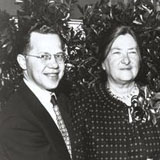Biography: Dr. Dorothy Hansine Andersen

Year: 1938
Achievement: Dr. Andersen was the first to recognize cystic fibrosis as a disease and helped create a test to diagnose it.
Dr. Dorothy Hansine Andersen was the first physician to identify cystic fibrosis as a disease and, together with her research team, created the first tests to diagnose it. She also spent nearly a decade examining glycogen storage disease, and studied cardiac malformations in great detail. She collected many specimens for her pathological research and left a valuable catalogue of disease used to pioneer new surgical treatments.
Born in Asheville, North Carolina, in 1901, Dorothy Andersen and her mother moved to Vermont after her Danish father died when she was 13. She attended Saint Johnsbury Academy and Mount Holyoke College. After earning her medical degree from Johns Hopkins University School of Medicine in 1926, Andersen completed a surgical internship at Strong Memorial Hospital in Rochester, New York, then taught anatomy at the University of Rochester. When she was denied a surgical residency at Strong because she was a woman, she joined the staff in the department of pathology at Columbia University College of Physicians and Surgeons. Between 1930 and 1935, while an instructor of pathology at Columbia, Andersen researched endocrine glands and female reproduction, also earning a doctorate of medical sciences in 1935.
That same year she took up a position as assistant pathologist at Babies Hospital at the Columbia-Presbyterian Medical Center. Interested in inherited malformations of the heart, she began to collect the hearts of infants born with cardiac defects. In the mid-1940s, surgeons pioneering open-heart surgery sought out Andersen's help because of her vast knowledge of infant cardiology and her collection of specimens. She used her store of knowledge and experience to develop a training program for cardiac surgeons at several hospitals.
In 1958, she was made chief of pathology at Columbia-Presbyterian Hospital and a full professor of pathology at the Columbia University College of Physicians and Surgeons.
Andersen's duties included performing autopsies. While conducting an autopsy on a child who had presented the clinical picture of celiac disease¿an illness caused by an intestinal hypersensitivity to gluten that inhibits digestion¿Andersen noticed a lesion in the pancreas. Following an extensive search of the autopsy records and related medical literature, she discovered a clear, though previously unrecognized, disease pattern. She called it cystic fibrosis. But Andersen did not think of herself solely as a pathologist and continued to work on diagnosing this new disease in living patients. Andersen and her research team made numerous discoveries that led to a simple diagnostic test for cystic fibrosis, one that is still in use today.
Dr. Andersen considered herself a rugged individualist, a pediatric clinician, a research chemist, and a roofer and carpenter happy to make her own home improvements. Routinely described as "windblown" by friends and detractors alike, she was considered quite a character. She is said to have kept a particularly untidy lab, holding semi-annual "glüg" parties there, in honor of her Scandinavian heritage.
Dr. Andersen was an honorary fellow of the American Academy of Pediatrics, and honorary chair of the National Cystic Fibrosis Research Foundation. She received numerous awards for her work, including the Elizabeth Blackwell Award in 1954 and the Distinguished Service Medal of the Columbia-Presbyterian Medical Center in 1963.




